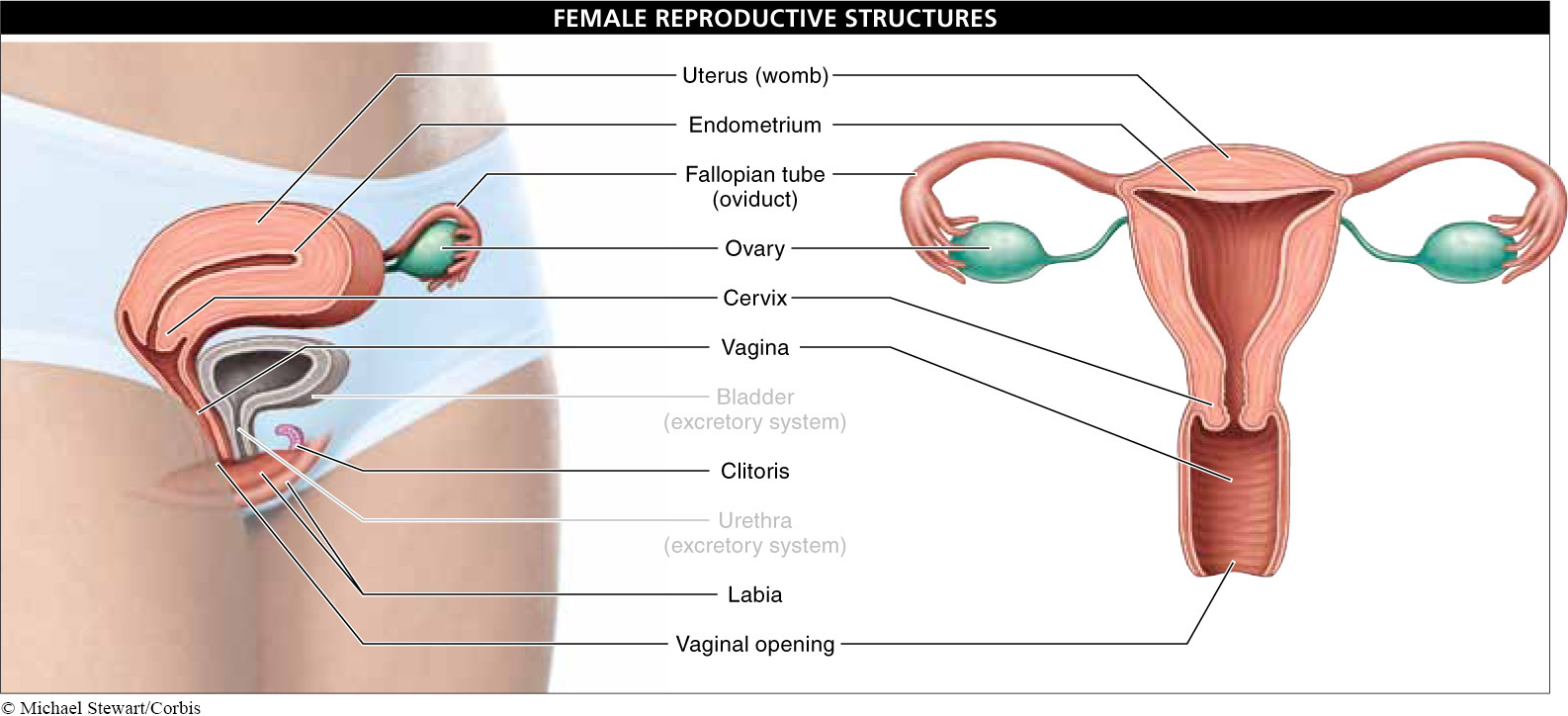25.7: Eggs are made in the ovaries (and the process can take decades).
From a genetic perspective, making eggs barely differs from making sperm. In the female gonads—the ovaries—diploid cells undergo meiosis to produce haploid eggs, and in the process, a great deal of variation is generated so that each haploid egg has a unique genetic makeup. When the haploid egg is fertilized by a sperm, the diploid condition is restored.
But the process of egg production differs from sperm production in several key ways. Eggs are produced in much smaller numbers; each egg is considerably larger than a sperm cell; and the production process can take decades rather than days, even though it begins at a much younger age. Let’s explore the specifics, beginning with a description of the female reproductive system (FIGURE 25-14).

Figure 25.14: The structures of the female reproductive system.
Female Reproductive Structures Externally, a female’s clitoris and labia develop from the same embryonic tissue that, in males, produces the penis and scrotum. There is also a vaginal opening. Internally, the vagina is a tube-like chamber into which sperm are released during copulation. The vagina connects with the uterus, also called the womb, where an embryo develops throughout pregnancy. The lower, narrowest portion of the uterus is called the cervix. The lining of the uterus, rich with blood vessels, is the endometrium, where the fertilized egg implants and is nourished.
Connecting to the top of the uterus on both sides are the Fallopian tubes, or oviducts. The Fallopian tubes extend outward and are funnel-shaped near the end where the ovaries lie. Each ovary is about the size of a large olive.
Gametogenesis in Females The process of gametogenesis in females, called oogenesis (pronounced oh-oh-gen-eh-sis), starts in the ovaries while the female is still a fetus (FIGURE 25-15). Here, diploid cells called oogonia (sing. oogonium) multiply by mitosis. Each oogonium then begins meiosis, but stops at prophase I, at which point the cell is called a primary oocyte and is contained within a follicle—the small structure in which an egg will form. At birth, there are approximately one million follicles in a female’s ovaries, each follicle containing a primary oocyte.

Figure 25.15: Gametogenesis in females.
The primary oocytes remain in their hibernation-like state until puberty. At that point, periodic bursts of follicle-stimulating hormone (FSH) cause several primary oocytes to complete meiosis I. Unlike in the production of sperm, however, when the primary oocyte divides into two cells, although the pairs of homologous chromosomes split evenly, nearly all of the cytoplasm goes to just one of the cells, now called a secondary oocyte. The other cell, known as a polar body, gets almost no cytoplasm and eventually disintegrates. At this point, meiosis again stops.
When females ovulate, generally a single follicle in one ovary ruptures, releasing the secondary oocyte—which still has not completed meiosis. The secondary oocyte, now called an egg, is swept by cilia into the Fallopian tube and carried down toward the uterus. If sperm have been deposited in the vagina during copulation, it is in the Fallopian tube that the sperm, swimming up from the vagina and through the uterus, are most likely to fertilize the egg. It is only after fertilization that a secondary oocyte is triggered to finally complete meiosis—once again with an unequal division of cytoplasm. One of the resulting cells, the ovum, receives most of the cytoplasm, while the other receives almost none. This second polar body disintegrates just as the first polar body did. The haploid ovum now fuses with the haploid nucleus of the sperm, forming a diploid fertilized egg, called a zygote.
In the next section, we see how the development of follicles, preparation of the uterus for implantation, and ovulation are coordinated by hormone secretions.
TAKE-HOME MESSAGE 25.7
Genetically, the production of eggs barely differs from sperm production. In the ovaries, diploid cells begin to undergo meiosis, a process that continues in the Fallopian tubes following ovulation, producing genetically varied haploid gametes. A much smaller number of eggs than sperm are produced, however, and each egg is considerably larger than a sperm cell.
During the two cell divisions that make up oogenesis, are the contents of the cells evenly divided? Explain.

